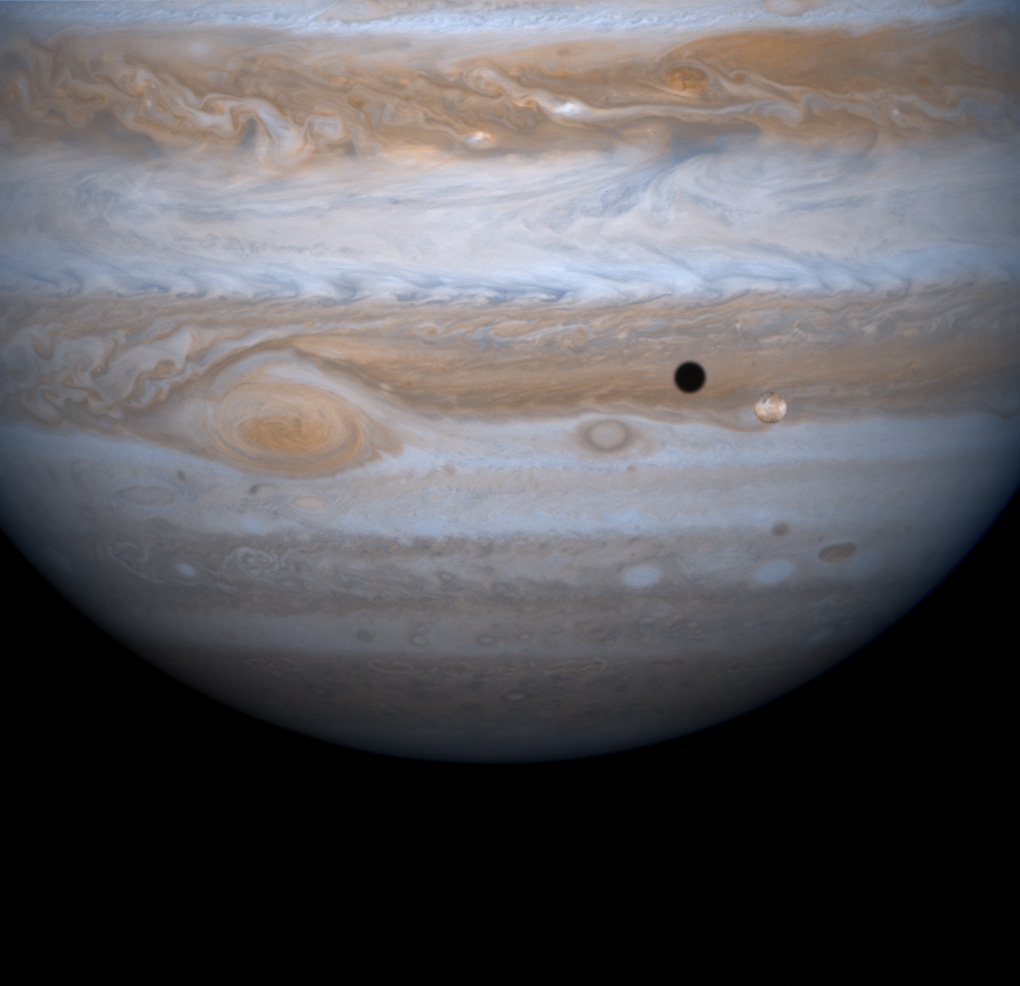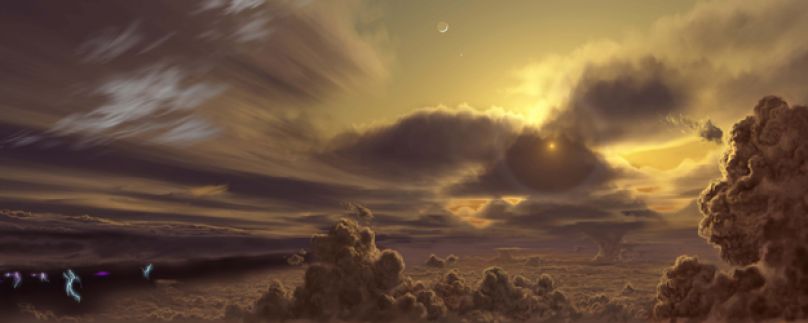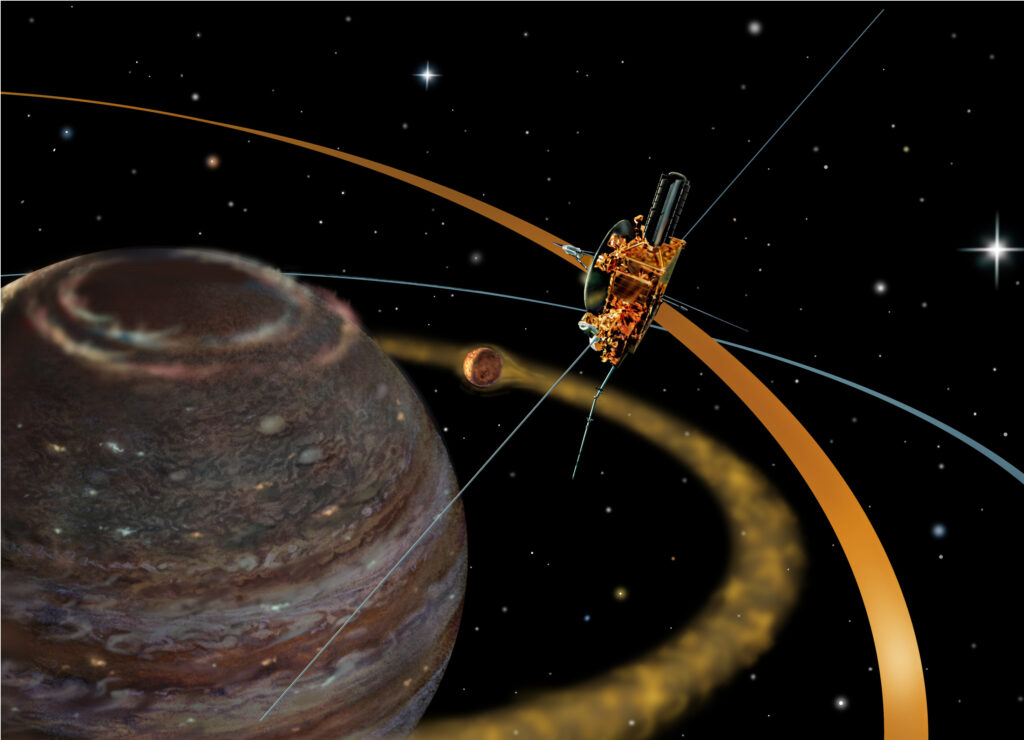King of the Gas Giants
© NASA
Table of Contents
Jupiter holds the title of being the most massive planet in our solar system and ranks fifth in distance from the Sun. It stands as one of the most luminous entities in the night sky, surpassed only by the Moon, Venus, and occasionally Mars. This colossal celestial body is classified as a gas giant, possessing a mass exceeding two and a half times the combined mass of all the other planets in the Solar System, yet it amounts to less than one one-thousandth of the Sun’s mass.
The planet is predominantly composed of hydrogen, accounting for 90% of its volume, followed by helium, which constitutes a quarter of its mass and a tenth of its volume. The ongoing contraction of Jupiter’s core generates a greater amount of heat than the planet receives from the Sun. The pressure in its deep interior is so high that the internal structure is believed to comprise an outer mantle of liquid metallic hydrogen and a diffuse inner core of denser material.
Because of its rapid rotation rate of 1 rotation per 10 hours, the planet’s shape is an oblate spheroid: it has a slight but noticeable bulge around the equator. The outer atmosphere is divided into a series of latitudinal bands, with turbulence and storms along their interacting boundaries.
Jupiter completes its orbit around the Sun in nearly 12 Earth years, exhibiting a remarkably rapid rotation of about every 10 hours—more than twice the pace of Earth. Even with a modest telescope, observers can discern its vivid cloud bands. This gas giant also possesses a slender set of rings and wields a robust magnetosphere, ranking as the second-largest continuous structure in the Solar System after the heliosphere.
Jupiter governs a system of 95 confirmed moons, with likely numerous others yet to be discovered. One of these moons surpasses the size of the planet Mercury, and three are larger than Earth’s Moon. Galileo Galilei identified the four prominent moons in 1610: Io, Europa, Ganymede, and Callisto. Among these, Ganymede, the largest, exceeds the size of Mercury, while Callisto follows as the second largest. Io and Europa are comparable to or even greater in size than Earth’s Moon. Some astronomers theorize that Jupiter’s moon Europa might harbor an expanse of warm water—potentially harboring some form of life—beneath its icy surface.
Since 1973, Jupiter has played host to nine robotic missions: seven flybys and two dedicated orbiters, with two more either currently in transit or awaiting launch.
Jupiter’s system is the source of intense bursts of radio noise, at some frequencies occasionally radiating more energy than the Sun. Despite all its superlatives, however, it is made almost entirely of only two elements, hydrogen and helium, and its mean density is not much more than the density of water.
ABOUT THE PLANET – JUPITER
Jupiter is believed to be the oldest planet in the Solar System. Current models of Solar System formation suggest that Jupiter formed at or beyond the snow line: a distance from the early Sun where the temperature was sufficiently cold for volatiles such as water to condense into solids. The planet’s origin traces back to a solid core that subsequently accrued its gaseous envelope. This implies that the planet likely formed before the complete dispersal of the solar nebula.
During its formation, Jupiter’s mass steadily increased until it reached 20 times the mass of Earth, with approximately half of it composed of silicates, ices, and other dense elements. Once the proto-Jupiter exceeded 50 times the mass of Earth, it carved a gap in the solar nebula. Subsequently, the burgeoning planet attained its ultimate mass within a span of 3 to 4 million years.
Jupiter’s atmosphere warms as one descends, achieving room temperature, or 70 degrees Fahrenheit (21 degrees Celsius), at an elevation where atmospheric pressure is roughly 10 times higher than that of Earth. Scientists speculate that if any form of life exists on the planet, it would likely be airborne at this altitude. A study in 2021 theoretically suggested there might be enough water to sustain some form of life. However, as of now, researchers have not discovered any evidence of life on Jupiter.
INTERNAL STRUCTURE

Jupiter boasts a captivating internal structure characterized by its immense size and complex composition. Beneath its iconic swirling clouds lies a structure defined by layers of varying states of matter, influenced by the planet’s colossal mass and gravitational forces.
At its core, the planet is believed to house a dense and relatively small core composed mainly of heavy elements such as rock and metal. This core is enveloped by a layer of high-pressure metallic hydrogen, where the intense gravitational forces cause hydrogen to behave like a metal. This layer gives rise to Jupiter’s powerful magnetic field, one of the strongest in the solar system. Above the metallic hydrogen layer, Jupiter’s atmosphere gradually transitions into a vast region of fluid hydrogen and helium. This region, often referred to as the “mantle,” is characterized by immense pressures and temperatures.
As depth increases, the pressures become so extreme that hydrogen molecules undergo a phase transition, forming a state known as “supercritical fluid,” where hydrogen transforms from a gas to a highly compressed fluid. The uppermost layer of Jupiter’s interior is its thick and dynamic atmosphere, consisting mainly of hydrogen and helium, with traces of other compounds. This gaseous envelope is renowned for its intricate cloud bands, iconic Great Red Spot, and numerous other storm systems. These features are driven by Jupiter’s rapid rotation, generating powerful atmospheric currents and eddies.
Jupiter’s internal structure offers a glimpse into the fundamental processes shaping the planet’s evolution and behaviour. Its core, enveloped by layers of exotic hydrogen states, contributes to the planet’s enormous size and powerful magnetic field. This magnetic field interacts with Jupiter’s surroundings, shaping its magnetosphere and influencing its many moons, including the four Galilean moons—Io, Europa, Ganymede, and Callisto.
SURFACE

Jupiter, often regarded as a gas giant due to its predominantly gaseous composition, lacks a traditional solid surface like the terrestrial planets. Instead, its surface is a complex interplay of dynamic cloud bands and atmospheric phenomena that create a mesmerizing and ever-changing visual spectacle. The visible “surface” of Jupiter, which is essentially the uppermost layer of its thick atmosphere, is characterized by its swirling cloud formations, intricate patterns, and iconic features.
One of the planet’s most renowned characteristics is the Great Red Spot, an enormous hurricane-like storm persisting for over three centuries. As per NASA, the Great Red Spot, at its broadest, spans approximately twice the size of Earth. Its outer edge rotates in a counterclockwise direction around its center, hurtling at velocities ranging from about 270 to 425 mph (430 to 680 kph). This counterclockwise rotation classifies it as a type of storm known as an “anticyclone.”
The hue of the storm, typically ranging from brick red to a slightly brownish tint, is thought to originate from trace amounts of sulfur and phosphorus present in the ammonia crystals within Jupiter’s clouds. This iconic spot has been gradually contracting over time, although the pace of this reduction may be decelerating in recent years.
Jupiter boasts an array of other tempestuous phenomena. Based on data from 2022 gathered by Juno, the colossal polar cyclones on Jupiter are propelled by convection, a process akin to the upward movement of heat from lower altitudes to higher regions in the atmosphere, much like how ocean vortices operate on Earth.
The surface of Jupiter’s atmosphere is further adorned with alternating light and dark cloud bands that stretch across the planet’s equatorial region. These bands are the result of Jupiter’s rapid rotation, which generates powerful jet streams that segregate different atmospheric gases and particles. The bands consist of both ammonia clouds at higher altitudes and water clouds at deeper levels.
Jupiter earned the moniker of the “Solar System’s vacuum cleaner” due to its substantial gravitational influence and its proximity to the inner regions of the Solar System. This giant planet experiences a higher frequency of impacts, including those from comets, than any other planet in the Solar System. To provide context, Jupiter encounters roughly 200 times more asteroid and comet impacts compared to Earth. Initially, scientists believed that Jupiter offered partial shielding to the inner system from comet impacts.
However, computer simulations conducted in 2008 proposed that Jupiter’s gravitational pull doesn’t result in a net reduction in the number of comets passing through the inner Solar System. Instead, it perturbs their orbits inward almost as frequently as it captures or ejects them. This subject remains a point of contention among scientists, with some positing that Jupiter may draw comets towards Earth from the Kuiper belt, while others contend that it shields Earth from the Oort cloud.
Jupiter possesses a faint planetary ring system comprising three primary segments: an inner accumulation of particles referred to as the halo, a relatively luminous central ring, and an outer gossamer ring. Unlike Saturn’s icy rings, these rings on Jupiter seem to be composed of dust particles. The primary ring is believed to consist largely of material expelled from the moons Adrastea and Metis, which is then pulled towards Jupiter due to the planet’s powerful gravitational pull. New material is added by additional impacts.
Similarly, the moons Thebe and Amalthea are believed to produce the two distinct components of the dusty gossamer ring. There is evidence of a fourth ring that may consist of collisional debris from Amalthea that is strung along the same moon’s orbit.
CHARACTERISTICS
| MASS | 1.8982×1027 kg |
| VOLUME | 1.4313×1015 km3 |
| SURFACE AREA | 6.1469×1010 km2 |
| MEAN RADIUS | 69,911 km |
| SURFACE PRESSURE | 200–600 kPa |
| DENSITY | 1326 kg/cm3 |
| ESCAPE VELOCITY | 59.5 km/s |
| SURFACE GRAVITY | 24.79 m/s2 |
| ABSOLUTE MAGNITUDE | -9.4 |
| NATURAL SATELLITES | 95 |
| RINGS | YES |
| MEAN TEMPERATURE | -185°C |
| SEMI-MAJOR AXIS | 778.479 Gm |
| ORBIT PERIOD | 4332.59 days |
| PERIHELION | 740.595 Gm |
| APHELION | 816.363 Gm |
| MEAN ORBITAL VELOCITY | 13.06 km/s |
| MAXIMUM ORBITAL VELOCITY | 13.72 km/s |
| MINIMUM ORBITAL VELOCITY | 12.44 km/s |
| ORBIT INCLINATION | 1.304° |
| ORBIT ECCENTRICITY | 0.0487 |
| SIDEREAL ROTATION PERIOD | 9.9250 hours |
| LENGTH OF DAY | 9.9259 hours |
| MINIMUM DISTANCE FROM EARTH | 588,500,000 km |
| MAXIMUM DISTANCE FROM EARTH | 968,500,000 km |
| MAXIMUM VISUAL MAGNITUDE | -2.7 |
ORBIT AND ROTATION

Jupiter traces an elliptical path around the Sun. It stands as the sole planet whose barycenter with the Sun exists outside the Sun’s volume, albeit only by approximately 7% of the Sun’s radius. Its orbit is distinguished by its substantial distance from the Sun, averaging about 778 million kilometers (483 million miles), and it completes a full orbit every 11.86 years. This timeframe roughly equates to two-fifths of Saturn’s orbital period, establishing a near resonance in their orbits. Jupiter’s orbital plane is inclined at 1.30° relative to Earth. With an eccentricity of 0.049, Jupiter is marginally over 75 million kilometers closer to the Sun at perihelion than at aphelion.
This relatively low eccentricity contrasts with exoplanet discoveries, which have unveiled Jupiter-sized planets with markedly higher eccentricities. Owing to its immense mass, Jupiter exerts a considerable gravitational influence, impacting the orbits of neighboring planets and celestial bodies.
Jupiter’s orbit is relatively eccentric, meaning it is more elongated compared to the nearly circular orbits of the inner planets. This eccentricity results in variations in its distance from the Sun during its orbit. Despite its elliptical path, Jupiter’s orbit is still much closer to being circular than those of some other planets, contributing to its relatively stable orbital dynamics.
Jupiter’s rotation is equally remarkable, standing out for its rapid speed and short day length. The planet completes a full rotation on its axis in just about 9.9 hours, making it one of the fastest-spinning planets in the solar system. This rapid rotation causes Jupiter to have an oblate spheroid shape, with its equatorial diameter being larger than its polar diameter. The combination of Jupiter’s rapid rotation and its massive size leads to the formation of distinctive cloud bands in its atmosphere. These bands, visible through telescopes, result from the differential rotation rates of the planet’s equator and poles, generating powerful atmospheric currents and jet streams that segregate different atmospheric gases.
Jupiter’s orbit and rotation have significant implications for its dynamic atmosphere and powerful magnetosphere. Its fast rotation influences its atmospheric dynamics, generating strong jet streams and shaping its cloud patterns. Furthermore, the planet’s powerful magnetic field interacts with its rapidly rotating metallic hydrogen interior, resulting in the generation of one of the strongest magnetic fields in the solar system.
ATMOSPHERE

Jupiter’s atmosphere is a captivating and dynamic realm of swirling clouds, powerful storms, and complex atmospheric phenomena which extend to a depth of 3,000 km (2,000 mi) below the cloud layers. Composed primarily of hydrogen and helium, the atmosphere of this gas giant spans thousands of kilometers in depth and is characterized by its mesmerizing visual features. Jupiter’s atmosphere is dominated by a series of alternating light and dark cloud bands that encircle the planet parallel to its equator. These bands are created by Jupiter’s rapid rotation, which generates powerful jet streams and atmospheric currents. The differential rotation between the equator and higher latitudes contributes to the distinct banding patterns.
Among Jupiter’s most iconic features is the Great Red Spot, an enormous storm system that has persisted for centuries. This anticyclonic storm is larger than Earth and is characterized by its deep red colour. Jupiter’s turbulent atmosphere is also home to other smaller storms and vortices, which ebb and flow in size and intensity.
Jupiter’s upper atmosphere features a series of ammonia clouds, while deeper layers are composed of water vapour clouds. These layers interact with the planet’s heat distribution, contributing to the creation of its intricate cloud patterns and atmospheric dynamics. These clouds are visible in a range of wavelengths, allowing scientists to study the composition and behaviour of Jupiter’s atmosphere in great detail.
Jupiter’s atmosphere is a place of extreme conditions. Powerful winds whip across the planet at speeds exceeding 600 kilometers per hour (370 miles per hour). The enormous mass of Jupiter and the resulting high pressure in its atmosphere give rise to intense gravitational forces that compress gases to high densities. The atmosphere of Jupiter also hosts phenomena like lightning, auroras, and radio emissions. Its immense magnetic field interacts with charged particles in the solar wind, leading to the creation of its extensive magnetosphere.
MAGNETIC FIELD

Jupiter boasts a powerful and intricate magnetic field that sets it apart as one of the most magnetically active planets in the solar system. This magnetic field is generated by the movements of electrically conducting material within the planet’s interior, particularly the layer of metallic hydrogen deep within its atmosphere.
Jupiter’s magnetic field is exceptionally strong, about 20,000 times more powerful than Earth’s magnetic field. This immense strength is a result of the planet’s rapid rotation, large size, and the presence of electrically conductive materials in its interior. The magnetic field is not centered at the planet’s physical center but is tilted relative to its rotational axis, resulting in a magnetic north pole that is distinct from the rotational north pole.
One of the most intriguing features of Jupiter’s magnetic field is the presence of its magnetosphere, an expansive region influenced by the planet’s powerful magnetic influence. This magnetosphere interacts with the solar wind, a stream of charged particles emitted by the Sun, creating phenomena such as auroras and radiation belts. Jupiter’s magnetosphere is so extensive that it extends far beyond the orbit of its largest moon, Ganymede, making Ganymede the only moon in the solar system known to possess its magnetosphere.
Jupiter’s complex magnetic field and magnetosphere have significant implications for its moons and the surrounding environment. The strong radiation belts within its magnetosphere can be hazardous to spacecraft and potentially affect the habitability of its moons. This magnetic environment also plays a role in shaping the behaviour and appearance of Jupiter’s iconic auroras, which are driven by charged particles interacting with the planet’s atmosphere.
GRAVITY

The planet’s gravity refers to the gravitational force exerted by the planet Jupiter. Gravity is a fundamental force of nature that attracts two objects with mass toward each other. The strength of this force depends on the mass of the objects and the distance between them. Jupiter is the largest planet in our solar system, with a mass more than 300 times that of Earth. Because of its immense size and mass, Jupiter has a very strong gravitational field. This means that any object near Jupiter will experience a powerful gravitational pull toward the planet’s center.
Jupiter’s gravity affects its moons significantly. It is responsible for keeping the planet’s numerous moons in orbit around the planet. The four largest moons of Jupiter—Io, Europa, Ganymede, and Callisto, known as the Galilean moons—are particularly well-known and were discovered by Galileo Galilei in 1610. Additionally, Jupiter’s strong gravitational influence can also have an effect on other objects in the solar system. For example, it can perturb the orbits of asteroids and comets that come too close, potentially redirecting their paths through space. Jupiter’s powerful gravity field makes it an influential celestial body in the dynamics of the solar system, and it plays a crucial role in shaping the behaviour and orbits of objects in its vicinity.
Previous Planet – “Mars“
Next Planet – “Saturn“
